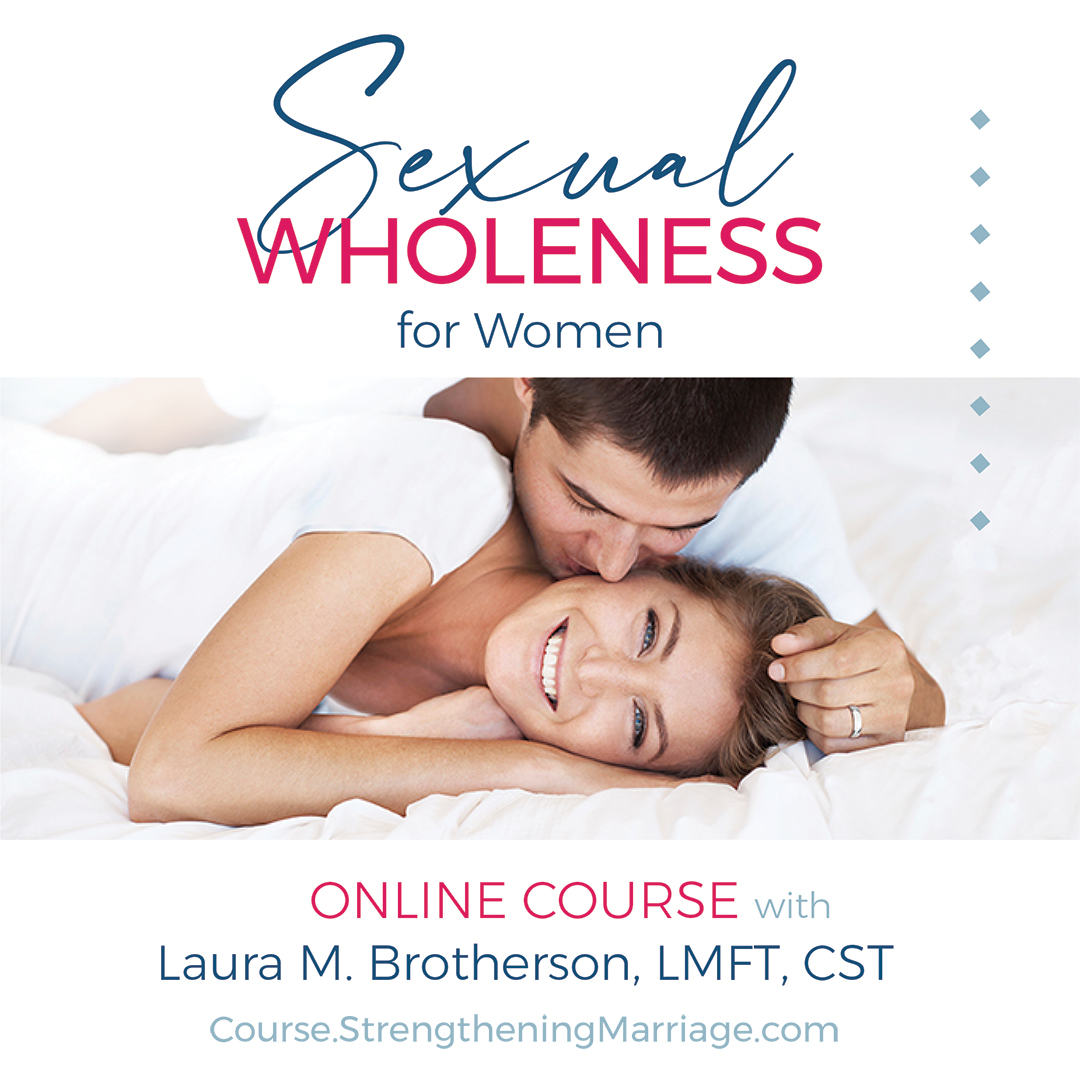A woman recently wrote me about her struggle to figure out what to do to be able to have an orgasm. Here’s what she had to say, as well as my response of some suggestions to consider regarding the 6 T’s of the female sexual response:
“I’ve been married for 24 yrs and I’ve never had an orgasm. In your book on page 78 it says: “Do I know what turns me on? Do I know what works best for stimulating my clitoris? Have I determined what kind of touch or stimulation is needed? When? What intensity, quantity, or speed is most arousing?”
I’m struggling with the fact that we aren’t supposed to masturbate yet throughout your book it talks about getting to know your body. To what extent are you really supposed to take this? I have a very obsessive and addictive personality. I feel if I were to do this it would definitely wind up being a self pleasuring activity for me. Yet I don’t know what I’m trying to accomplish, feel, etc. with an orgasm.”
It’s important to consider the whole package when determining what’s needed to experience the ecstasy of orgasm. Particularly for women, it’s not just a sexual “technique” that’s usually missing.
While clitoral stimulation is important, it’s possible that the real culprit lies somewhere else, such as in the relationship, or in your thoughts and beliefs about sex. We need to consider the way women are wired sexually, then see which area seems to be lacking. So, let’s take a look at each of the 6 T’s of the female sexual response and go from there:
- Thoughts
- Tenderness
- Teasing/Playfulness
- Talk
- Touch
- Time
First — your Thoughts. Sex is something that requires the full engagement of the heart and mind, especially for women. If your thoughts include things such as:
- “My husband seems bored,” or
- “Is it going to happen this time?” or
- “Gee, this is taking a long time,” or
- “Boy, I don’t know about this orgasm stuff. I don’t know what it’s going to feel like. What if I don’t like it? What if I do or say something embarrassing,” or
- “I wonder if I’m doing this right,” or
- “I wish my husband would do such and such instead,” or
- “I wonder if the kids can hear us?” or
- “I hope I won’t disappoint my husband this time, and finally have an orgasm,” etc.
…then it will be very difficult for your mind to fully engage in the sexual experience.
I’ve come to the understanding that fully experiencing lovemaking is very much like experiencing true faith–not just a generic kind of faith we often talk about in Sunday School. True faith is the belief that something you desire will definitely happen (or something even better), but it is accompanied by an emotional detachment that turns the matter over to God for it to happen in it’s rightful time and way. In other words, you must believe, then let go of it emotionally.
One of the hardest things for women is to approach having an orgasm with that necessary mindset. The more we get worked up about having an orgasm or the more we “want” it to happen or obsess about it the less likely it will. It’s a horribly challenging paradox I know.
The words that best describe this necessary state of mind is a confident/believing and relaxed “letting go.” All of this begins in the mind with our automatic thoughts and also our core beliefs. This is why any “good girl syndrome” issues or even just any form of negative or unproductive thoughts and beliefs and attitudes about sex can so easily get in the way of thoroughly engaging or enjoying sex or, more specifically, experiencing an orgasm.
There’s a lot of mental training or mental skill acquisition that is necessary for many women to fully experience sex as it was intended by God. This is where the help of a sex therapist or maybe even a brief phone consultation with me could get you moving in the right direction. (You can check out that option on our website.)
Secondly, Tenderness represents the relationship issues and emotional connection in the relationship. Emotional intimacy is a woman’s primary foreplay. Are you being loved by your spouse in a way that truly makes you feel loved? Do you feel close and emotionally connected to your husband? Are there any relationship issues that may be getting in the way of you truly letting go and fully engaging in the sexual experience?
Thirdly, Teasing and Playfulness helps you create the kind of environment for an orgasm to most easily occur. If lovemaking feels like a performance by either of you it will limit the mutual fulfillment that is possible and inhibit the sexual response. Being playful with each other outside of the sexual relationship is the best way to practice for relaxed playfulness within lovemaking.
Fourth, Talk. Conversation is one of the key ways for emotional connection (mentioned above) to be created. Being able to openly and honestly share your heart and soul with your spouse provides the necessary “emotional foreplay” women need to fully engage and let themselves go into the flow of orgasm.
I might also add that another use of “talk” within lovemaking is a concept I call “auditory arousal” (see “And They Were Not Ashamed,” pg 133-135). It’s a way for a woman to focus her attention and fully engage in the sexual experience by verbalizing her feelings and experience with each sexual sensation. When the mind is focusing on fully experiencing and savoring every touch and kiss and caress and verbalizing the pleasure with “Mmmmms” and “Ahhhhhhhhhs” and “I love the way you…” then it keeps the mental clutter and distractions mentioned earlier from derailing the pleasure train.
Fifth, Touch. One of the most common physical inhibitors of a full sexual response is insufficient clitoral stimulation. Most women do not experience an orgasm without direct clitoral stimulation, and direct clitoral stimulation does not generally occur automatically during intercourse except in the woman-on-top position (for some women).
Most women need their husbands to manually stimulate their clitoris in addition to whatever other sexual stimulation they need to reach orgasm, such as kissing and/or caressing other erogenous parts. (This is where the male/female sexual wiring differences picture shown here has some real validity.)
And some women even find that it’s not so much the actual touching of the clitoris, but the pressure on the clitoris that makes the difference. Whether the husband is putting pressure on the clitoris and/or stimulating it with the right kind of touch for his wife or she is using his thigh or penis in a way to gain the clitoral stimulation she needs, couples need to practice and have patience as they figure this stuff out.
Regarding the section you mention in our book about learning about your body, the “self-learning” section was removed in the 2nd and following printings to put the focus more on a couple doing the learning together. Of course that is ideal, but for some couples, especially after 24 years of orgasm-less sex for the wife, it might be something they could consider for her to see if she can figure out what works outside the psychological pressure that potentially exists within the “bedroom” of the sexual relationship.
This kind of learning is a completely different thing than masturbation, but I realize that some people just don’t see how the two are very different, even though I have thoroughly addressed the stark differences between masturbation and “self-learning.” Masturbation is something you do alone with selfish intent for your own pleasure. Self-learning is a short-term endeavor — something you do for your husband and your marriage. The intentions and outcomes between masturbation and self-learning are entirely different.
You bring up a good point that you are concerned about having an addictive susceptibility with regard to doing any self-learning. That is definitely something you need to take into account when determining your best course of action. You don’t have to figure it out on your own. Hopefully you and your husband can figure it out together, I just don’t consider this “last-resort” type option to be completely off the table if you’ve already tried everything you can already think of during the last 24 years of marriage. As I’ve said, it’s not necessary for you to do any self-learning on your own unless that seems like the best option for you.
You and your husband really need to go on a fun sexual adventure of trying every kind of touch and position and lighting and music and connecting and stimulating that you can think of…as if you were doing a fun research project on your sexuality. You could even try taking your husband’s hand or finger or whatever and seeing what kind of stimulation you can guide him to create to see what works best for you.
Some people have a fear of losing control, which inhibits their sexual response. Experiencing an orgasm is not about “losing control” but allowing yourself to get on the pleasure plane that will take you and your husband to the exquisite wonderland of sexual bliss or the mutual sexual fulfillment of orgasm.
The sixth T is Time. It can take even an hour of direct clitoral stimulation the first few times for the body to work itself up enough to release the pressured pleasure. Couples really need to set aside sufficient, unrushed, pleasure time for the sexual learning and adventure to naturally unfold. The focus must be on enjoying every sensation NOT on the “outcome” of an orgasm itself.
This is all easier said than done. How do you maintain a state of faith that orgasm will occur and yet not focus on it to the point of inhibiting it. Being patient not only within the lovemaking experience but also throughout the course of “practicing” until you get there is very important.
I’m sure your husband could see, if he reads this, what he might be able to do to help you in this sexual adventure. Read and discuss these ideas and choose one or two things to add to your relationship and to your lovemaking then go from there.
For those who have yet to experience an orgasm, it is certainly an unknown. It can be valuable to have some good idea of what you’re looking for or what an orgasm feels like. The following are a few descriptions of an orgasm from our book “And They Were Not Ashamed” (pg. 72-73) that may be helpful:
“Orgasm is the physiological response which brings sexual intercourse to its natural and beautiful termination . . . . In the moment just preceding orgasm, muscular tension suddenly rises. . . .
At the moment of greatest muscular tension all sensations seem to take one further rise upward. The woman tenses beyond the point where, it seems, it would be possible to maintain such tension for a moment longer. And indeed it is not possible, and now her whole body suddenly plunges into a series of muscular spasms. These spasms take place within the vagina itself, shaking the body with waves of pleasure. . . .
If a woman is [sexually] satisfied by her orgasmic experience she will discharge the neurological and muscular tension developed in the sexual buildup.”
~~~~~~~~~~~~~~~~~~~~
“[Orgasm] has been described as a momentary feeling of suspension, followed by a sensation of warmth starting in the perineal area and pervading the entire body. Rhythmic contractions of the lower third of the vagina follow. There may be from three to ten contractions over the period of a few seconds. She can increase the intensity of the physical sensations by voluntarily strengthening her P.C. muscle contractions . . . as she lets herself go in seeking release. As her physical movements, her response to her partner’s stimulation and her own mental concentration blend into a total reaching for satisfaction, she comes to climax—often an emotional mountain-peak experience, when the rest of the world recedes and seems to stand still—a high point of feeling, best described as ecstasy.
Sometimes a woman does not know if she has experienced an orgasm. If you feel your vagina contracting involuntarily, if you feel excited at first, and later feel calm and physically satisfied, you can take this as evidence that you have had an orgasm….”
~~~~~~~~~~~~~~~~~~~~
“Orgasm might also be described as pleasurable sensations that slowly build, until the sexual tension bursts into a shooting star throughout the body. Rapid involuntary contractions or spasms radiate from the vagina and genitals. What began with some concentration on your part builds into a sexual crescendo until the sensations overtake you, reaching a fevered pitch. The sensations surge in intensity, momentarily transporting you from the present to an uninhibited wonderland. Like a sunburst of warmth and energy, the feelings penetrate your body, mind and spirit—coursing through you like an overwhelming, yet tangible feeling of love and ecstasy. The rush of blood to the genitals creates pleasurable pulsations and a soft fulness. It may even feel as if your heart is beating and pulsating in the genital area.”
~~~~~~~~~~~~~~~~~~~~
I would also recommend that you and your husband read or re-read chaps 3, 4 and 5 of “And They Were Not Ashamed,” which give detailed insights about the female sexual response, as well as the various differences in sexual wiring between men and women. Practice lots, have fun, be patient and believing, and let go of it all. It will happen…!

























Is it possible to have experienced an orgasm and to not know for sure, or if you have one, you definitely know it?
Those articles above spell it out pretty well. My understanding is that if you had an orgasm you would know it. Anything else is just on the way there…